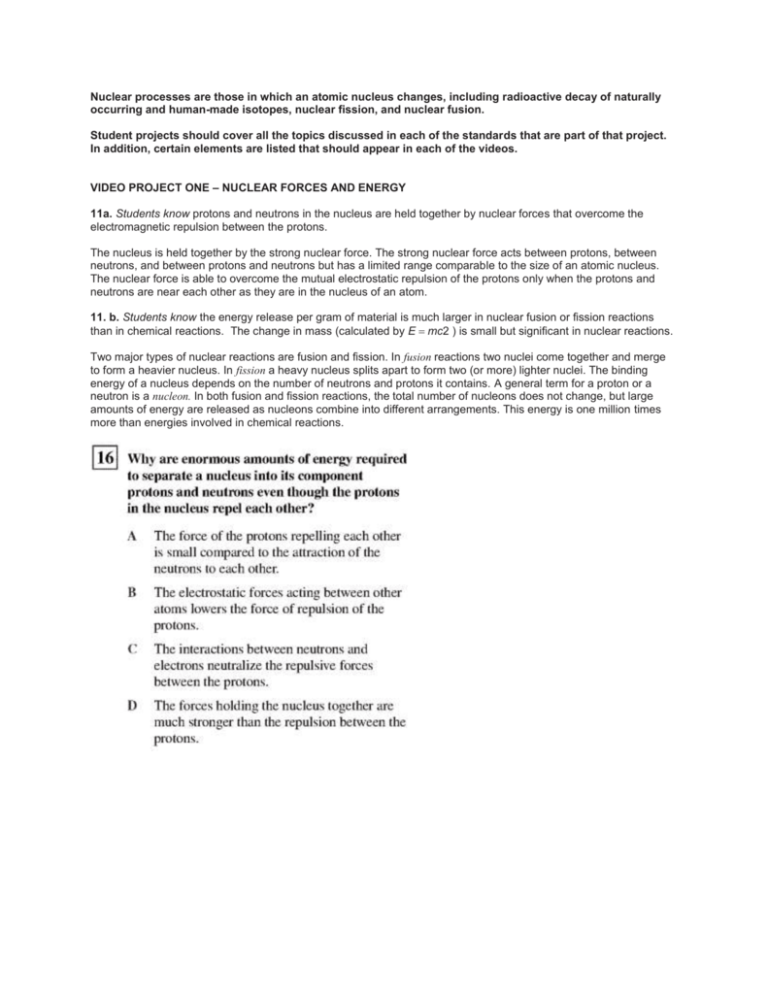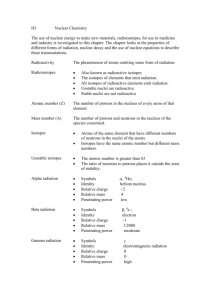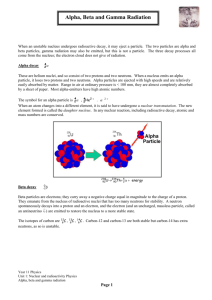Nuclear processes are those in which an atomic nucleus changes
advertisement

Nuclear processes are those in which an atomic nucleus changes, including radioactive decay of naturally occurring and human-made isotopes, nuclear fission, and nuclear fusion. Student projects should cover all the topics discussed in each of the standards that are part of that project. In addition, certain elements are listed that should appear in each of the videos. VIDEO PROJECT ONE – NUCLEAR FORCES AND ENERGY 11a. Students know protons and neutrons in the nucleus are held together by nuclear forces that overcome the electromagnetic repulsion between the protons. The nucleus is held together by the strong nuclear force. The strong nuclear force acts between protons, between neutrons, and between protons and neutrons but has a limited range comparable to the size of an atomic nucleus. The nuclear force is able to overcome the mutual electrostatic repulsion of the protons only when the protons and neutrons are near each other as they are in the nucleus of an atom. 11. b. Students know the energy release per gram of material is much larger in nuclear fusion or fission reactions than in chemical reactions. The change in mass (calculated by E mc2 ) is small but significant in nuclear reactions. Two major types of nuclear reactions are fusion and fission. In fusion reactions two nuclei come together and merge to form a heavier nucleus. In fission a heavy nucleus splits apart to form two (or more) lighter nuclei. The binding energy of a nucleus depends on the number of neutrons and protons it contains. A general term for a proton or a neutron is a nucleon. In both fusion and fission reactions, the total number of nucleons does not change, but large amounts of energy are released as nucleons combine into different arrangements. This energy is one million times more than energies involved in chemical reactions. VIDEO PROJECT TWO – ISOTOPES AND THE PARTICLES THEY EMIT 11. c. Students know some naturally occurring isotopes of elements are radioactive, as are isotopes formed in nuclear reactions. Sometimes atoms with the same number of protons in the nucleus have different numbers of neutrons. These atoms are called isotopes of an element. Both naturally occurring and human-made isotopes of elements can be either stable or unstable. Less stable isotopes of one element, called parent isotopes, will undergo radioactive decay, transforming to more stable isotopes of another element, called daughter products, which can also be either stable or radioactive. For a radioactive isotope to be found in nature, it must either have a long half-life, such as potas-sium-40, uranium238, uranium-235, or thorium-232, or be the daughter product, such as radon-222, of a parent with a long half-life, such as uranium-238. 11. d. Students know the three most common forms of radioactive decay (alpha, beta, and gamma) and know how the nucleus changes in each type of decay. Radioactive isotopes transform to more stable isotopes, emitting particles from the nucleus. These particles are helium-4 nuclei (alpha radiation), electrons or positrons (beta radiation), or high-energy electromagnetic rays (gamma radiation). Isotopes of elements that undergo alpha decay produce other isotopes with two less protons and two less neutrons than the original isotope. Uranium-238, for in-stance, emits an alpha particle and becomes thorium-234. Isotopes of elements that undergo beta decay produce elements with the same number of nucleons but with one more proton or one less proton. For example, thorium-234 beta decays to protactinium-234, which then beta decays to uranium-234. Alpha and beta decay are ionizing radiations with the potential to damage surrounding materials. After alpha and beta decay, the resulting nuclei often emit high-energy photons called gamma rays. This process does not change the number of nucleons in the nucleus of the isotope but brings about a lower energy state in the nucleus. VIDEO PROJECT THREE – THE EFFECTS OF DIFFERENT TYPES OF RADIATION 11. e. Students know alpha, beta, and gamma radiation produce different amounts and kinds of damage in matter and have different penetrations. Alpha, beta, and gamma rays are ionizing radiations, meaning that those rays produce tracks of ions of atoms and molecules when they interact with materials. For all three types of rays, the energies of particles emitted in radioactive decay are typically for each particle on the order of 1MeV, equal to 1.6 X 1013 joule, which is enough energy to ionize as many as half a million atoms. Alpha particles have the shortest ranges, and matter that is only a few millimeters thick will stop them. They will not penetrate a thick sheet of paper but will deposit all their energy along a relatively short path, resulting in a high degree of ionization along that path. Beta particles have longer ranges, typically penetrating matter up to several centimeters thick. Those particles are electrons or positrons (the antimatter electron), have one unit of either negative or positive electric charge, and are approximately 1/2000 of the mass of a proton. These high-energy electrons have longer ranges than alpha particles and deposit their energy along longer paths, spreading the ionization over a greater distance in the material. Gamma rays can penetrate matter up to several meters thick. Gamma rays are high-energy photons that have no electric charge and no rest mass (the structural energy of the particle). They will travel unimpeded through materials until they strike an electron or the nucleus of an atom. The gamma ray’s energy will then be either completely or partially absorbed, and neighboring atoms will be ionized. Therefore, these three types of radiation interact with matter by losing energy and ionizing surrounding atoms. Alpha radiation is dangerous if ingested or inhaled. For example, radon-222, a noble gas element, is a naturally occurring hazard in some regions. Living organ-isms or sensitive materials can be protected from ionizing radiation by shielding them and increasing their distance from radiation sources. Because many people deeply fear and misunderstand radioactivity, chemistry teachers should address and explore the ability of each form of radiation to penetrate matter and cause damage. Students may be familiar with radon detection devices, similar to smoke detectors, found in many homes. Discussion of biological and health effects of ionizing radiation can inform students about the risks and benefits of nuclear reactions. Videos can be used in the classroom to show demonstrations of the penetrating ability of alpha, beta, and gamma radiation through paper, aluminum, and lead or through other dense substances of varying thicknesses. Geiger counter measurements can be used to record radiation data. The order of penetrating ability, from greatest to least, is gamma > beta > alpha, and this order is the basis for assessing proper shielding of radiation sources for safety. There are a number of naturally occurring sources of ionizing radiation. One is potassium-40, which can be detected easily in potash fertilizer by using a Geiger counter. The other is background cosmic and alpha radiation from radon. This radiation can be seen in cloud chambers improvised in the classroom.







